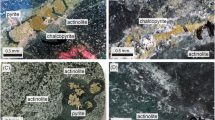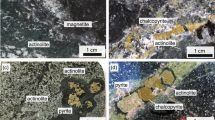Abstract
Giant ore deposits contain anomalously large quantities of metal and are priority targets for mineral exploration companies. It is debated whether these giant deposits have a unique mode of formation. Alternatively they may simply represent the extreme end of a spectrum of deposit sizes, formed by an optimum coincidence of common geological processes to build unusually large accumulations of metal. If formed by unique processes, the occurrence of giant ore deposits may be difficult to predict. Conversely, if formed by common processes, understanding the mechanisms that lead to optimum circumstances for giant metal deposits could help with exploration. A review of several giant porphyry copper–molybdenum–gold and epithermal gold–silver deposits reveals that many have characteristics consistent with formation during the optimization of normal ore-forming processes. In several cases, the large size of the deposit reflects specific factors, such as distinct tectonic configurations, reactive host rocks or focused fluid flow, that are not unusual by themselves but have helped to enhance the overall process. Thus, I suggest that effective exploration for giant deposits should seek distinct conditions within fundamentally prospective geological settings that might lead to enhanced ore-forming processes.
This is a preview of subscription content, access via your institution
Access options
Subscribe to this journal
Receive 12 print issues and online access
$259.00 per year
only $21.58 per issue
Buy this article
- Purchase on Springer Link
- Instant access to full article PDF
Prices may be subject to local taxes which are calculated during checkout


Similar content being viewed by others
References
Singer, D. A. World class base and precious metal deposits: A quantitative analysis. Econ. Geol. 90, 88–104 (1995).
Jaireth, S. & Huston, D. Metal endowment of cratons, terranes and districts: Insights from a quantitative analysis of regions with giant and super-giant deposits. Ore Geol. Rev. 38, 288–303 (2010).
Ballantyne, G., Maughan, C. J. & Smith, T. in Giant Ore Deposits II, Proceedings (ed. Clark, A. H.) 300–315 (QMinEx Associates, 1995).
Keith, J. D. et al. The role of magmatic sulfides and mafic alkaline magmas in the Bingham and Tintic mining districts, Utah. J. Petrol. 38, 1679–1690 (1997).
Core, D. P., Kesler, S. E. & Essene, E. J. Unusually Cu-rich magmas associated with giant porphyry copper deposits: Evidence from Bingham, Utah. Geology 34, 41–44 (2006).
Pettke, T., Oberli, F. & Heinrich, C. A. The magma and metal source of giant porphyry-type ore deposits, based on lead isotope microanalysis of individual fluid inclusions. Earth Planet. Sci. Lett. 296, 267–277 (2010).
Hou, Z. et al. The Miocene Gangdese porphyry copper belt generated during post-collisional extension in the Tibetan Orogen. Ore Geol. Rev. 36, 25–51 (2009).
Richards, J. P. Postsubduction porphyry Cu–Au and epithermal Au deposits: Products of remelting of subduction-modified lithosphere. Geology 37, 247–250 (2009).
Shafiei, B., Haschke, M. & Shahabpour, J. Recycling of orogenic arc crust triggers porphyry Cu mineralization in Kerman Cenozoic arc rocks, southeastern Iran. Mineral. Depos. 44, 265–283 (2009).
Cannell, J., Cooke, D. R., Walshe, J. L. & Stein, H. Geology, mineralization, alteration, and structural evolution of the El Teniente porphyry Cu–Mo deposit. Econ. Geol. 100, 979–1003 (2005).
Skewes, M. A., Arévalo, A., Floody, R., Zuñiga, P. H. & Stern, C. R. The giant El Teniente breccia deposit: Hypogene copper distribution and emplacement. Soc. Econ. Geol. Spec. Publ. 9, 299–332 (2002).
Rabbia, O. M., Hernández, L. B., French, D. H., King, R. W. & Ayers, J. C. The El Teniente porphyry Cu–Mo deposit from a hydrothermal rutile perspective. Mineral. Depos. 44, 849–866 (2009).
Vry, V. H., Wilkinson, J. J., Seguel, J. & Millan, J. Multistage intrusion, brecciation, and veining at El Teniente, Chile: Evolution of a nested porphyry system. Econ. Geol. 105, 119–153 (2010).
Klemm, L. M., Pettke, T., Heinrich, C. A. & Campos, E. Hydrothermal evolution of the El Teniente deposit, Chile: Porphyry Cu–Mo ore deposition from low-salinity magmatic fluids. Econ. Geol. 102, 1021–1046 (2007).
Maksaev, V. et al. New chronology for El Teniente, Chilean Andes, from U–Pb, 40Ar/39Ar, Re–Os, and fission-track dating: Implications for the evolution of a supergiant porphyry Cu–Mo deposit. Soc. Econ. Geol. Spec. Publ. 11, 15–54 (2004).
Kay, S. M., Mpodozis, C. & Coira, B. Neogene magmatism, tectonism, and mineral deposits of the Central Andes (22 to 33° S latitude). Soc. Econ. Geol. Spec. Publ. 7, 27–59 (1999).
Stern, C. R., Skewes, M. A. & Arevalo, A. Magmatic evolution of the giant El Teniente Cu–Mo deposit, Central Chile. J. Petrol. 52, 1591–1617 (2011).
Muñoz, M., Charrier, R., Fanning, C. M., Maksaev, V. & Deckart, K. Zircon trace element and O–Hf isotope analyses of mineralized intrusions from El Teniente ore deposit, Chilean Andes: Constraints on the source and magmatic evolution of porphyry Cu–Mo related magmas. J. Petrol. 53, 1091–1122 (2012).
Manske, S. L. & Paul, A. H. Geology of a major new porphyry copper center in the Superior (Pioneer) district, Arizona. Econ. Geol. 97, 197–220 (2002).
Sillitoe, R. H. Porphyry copper systems. Econ. Geol. 105, 3–41 (2010).
Pollard, P. J., Taylor, R. G. & Peters, L. Ages of intrusion, alteration, and mineralization at the Grasberg Cu–Au deposit, Papua, Indonesia. Econ. Geol. 100, 1005–1020 (2005).
Cloos, M. & Housh, T. B. Collisional delamination: Implications for porphyry-type Cu–Au ore formation in New Guinea. Arizona Geol. Soc. Digest 22, 235–244 (2008).
Sapiie, B. & Cloos, M. Strike-slip faulting in the core of the Central Range of west New Guinea: Ertsberg Mining District, Indonesia. Geol. Soc. Am. Bull. 116, 277–293 (2004).
Paterson, J. T. & Cloos, M. in Super Porphyry Copper and Gold Deposits: A Global Perspective Vol. 2 (ed. Porter, T. M.) 331–355 (Porter Geoscience Consulting, 2005).
Meinert, L. D., Hefton, K. K., Mayes, D. & Tasiran, I. Geology, zonation, and fluid evolution of the Big Gossan Cu–Au skarn deposit, Ertsberg district, Irian Jaya. Econ. Geol. 92, 509–534 (1997).
Perelló J. et al. Oyu Tolgoi, Mongolia: Siluro-Devonian porphyry Cu–Au–(Mo) and high-sulfidation Cu mineralization with a Cretaceous chalcocite blanket. Econ. Geol. 96, 1407–1428 (2001).
Wainwright, A. J. et al. Devonian and Carboniferous arcs of the Oyu Tolgoi porphyry Cu–Au district, South Gobi region, Mongolia. Geol. Soc. Am. Bull. 123, 306–328 (2011).
Khashgerel, B. E., Rye, R. O., Hedenquist, J. W. & Kavalieris, I. Geology and reconnaissance stable isotope study of the Oyu Tolgoi porphyry Cu–Au System, South Gobi, Mongolia. Econ. Geol. 101, 503–522 (2006).
Khashgerel, B-E., Rye, R. O., Kavalieris, I. & Hayashi, K-i. The sericitic to advanced argillic transition: stable isotope and mineralogical characteristics from the Hugo Dummett porphyry Cu–Au deposit, Oyu Tolgoi District, Mongolia. Econ. Geol. 104, 1087–1110 (2009).
Müller, A. et al. Trace elements and cathodoluminescence of quartz in stockwork veins of Mongolian porphyry-style deposits. Mineral. Depos. 45, 707–727 (2010).
Laznicka, P. Quantitative relationships among giant deposits of metals. Econ. Geol. 94, 455–473 (1999).
Simmons, S. F., White, N. C. & John, D. A. Geological characteristics of epithermal precious and base metal deposits. Economic Geology 100th Anniversary Volume, 485–522 (2005).
Barick Gold Corporation; http://www.barrick.com.
Mueller, A. G., Hall, G. C., Nemchin, A. A. & O'Brien, D. Chronology of the Pueblo Viejo epithermal gold–silver deposit, Dominican Republic: Formation in an Early Cretaceous intra-oceanic island arc and burial under ophiolite. Mineral. Depos. 43, 873–889 (2008).
Kesler, S. E., Campbell, I. H., Smith, C. N., Hall, C. M. & Allen, C. M. Age of the Pueblo Viejo gold–silver deposit and its significance to models for high-sulfidation epithermal mineralization. Econ. Geol. 100, 253–272 (2005).
Sillitoe, R. H., Hall, D. J., Redwood, S. D. & Waddell, A. H. Pueblo Viejo high-sulfidation epithermal gold-silver deposit, Dominican Republic: A new model of formation beneath barren limestone cover. Econ. Geol. 101, 1427–1435 (2006).
Bissig, T., Clark, A. H., Lee, J. K. W. & Hodgson, C. J. Miocene landscape evolution and geomorphologic controls on epithermal processes in the El Indio-Pascua Au–Ag–Cu belt, Chile and Argentina. Econ. Geol. 97, 971–996 (2002).
Bissig, T., Clark, A. H., Lee, J. K. W. & von Quadt, A., Petrogenetic and metallogenetic response to Miocene slab flattening: New constraints from the El Indio-Pascua Au–Ag–Cu belt, Chile/Argentina. Mineral. Depos. 38, 844–862 (2003).
Oyarzun, R., Lillo, J., Oyarzun, J. & Higueras, P. Plate interactions, evolving magmatic styles, and inheritance of structural paths: Development of the gold-rich, Miocene El Indio epithermal belt, Northern Chile. Int. Geol. Rev. 49, 844–853 (2007).
Richards, J. P., Bray, C. J., Channer, D. M. DeR. & Spooner, E. T. C. Fluid chemistry and processes at the Porgera gold deposit, Papua New Guinea. Mineral. Depos. 32, 119–132 (1997).
Richards, J. P., Chappell, B. W. & McCulloch, M. T. Intraplate-type magmatism in a continent-island-arc collision zone: Porgera intrusive complex, Papua New Guinea. Geology 18, 958–961 (1990).
Richards, J. P. & Kerrich, R. The Porgera gold mine, Papua New Guinea: Magmatic-hydrothermal to epithermal evolution of an alkalic-type precious metal deposit. Econ. Geol. 88, 1017–1052 (1993).
Lowell, J. D. & Guilbert, J. M. Lateral and vertical alteration-mineralization zoning in porphyry copper ore deposits. Econ. Geol. 65, 373–408 (1970).
Richards, J. P. Tectono-magmatic precursors for porphyry Cu–(Mo–Au) deposit formation. Econ. Geol. 98, 1515–1533 (2003).
Cooke, D. R., Hollings, P. & Walshe, J. L. Giant porphyry deposits: Characteristics, distribution, and tectonic controls. Econ. Geol. 100, 801–818 (2005).
Richards, J. P. in Super Porphyry Copper and Gold Deposits: A Global Perspective Vol. 1 (ed. Porter, T. M.) 7–25 (Porter Geoscience Consulting Publishing, 2005).
Richards, J. P. Magmatic to hydrothermal metal fluxes in convergent and collided margins. Ore Geol. Rev. 40, 1–26 (2011).
Seedorff, E. et al. Porphyry deposits: Characteristics and origin of hypogene features. Economic Geology 100th Anniversary Volume 251–298 (2005).
Gill, J. B. Orogenic Andesites and Plate Tectonics (Springer, 1981).
Cooke, D. R. & Simmons, S. F. Characteristics and genesis of epithermal gold deposits. Rev. Econ. Geol. 13, 221–244 (2000).
Simmons, S. F., White, N. C. & John, D. A. Geological characteristics of epithermal precious and base metal deposits. Economic Geology 100th Anniversary Volume, 485–522 (2005).
Einaudi, M. T., Hedenquist, J. W. & Inan, E. E. Sulfidation state of fluids in active and extinct hydrothermal systems: Transitions from porphyry to epithermal environments. Soc. Econ. Geol. Spec. Publ. 10, 285–313 (2003).
Sillitoe, R. H. & Hedenquist, J. W. Linkages between volcanotectonic settings, ore-fluid compositions, and epithermal precious metal deposits. Soc. Econ. Geol. Spec. Publ. 10, 315–343 (2003).
Richards, J. P. in Magmas, Fluids, and Ore Deposits (ed. Thompson, J. F. H.) 367–400 (Mineral. Assoc. Canada, 1995).
Jensen, E. P. & Barton, M. D. Gold deposits related to alkaline magmatism. Rev. Econ. Geol. 13, 279–314 (2000).
Acknowledgements
I acknowledge the support of a Discovery Grant from the Natural Sciences and Engineering Research Council of Canada.
Author information
Authors and Affiliations
Corresponding author
Ethics declarations
Competing interests
The author declares no competing financial interests.
Supplementary information
Supplementary Information
Supplementary Information (PDF 3294 kb)
Rights and permissions
About this article
Cite this article
Richards, J. Giant ore deposits formed by optimal alignments and combinations of geological processes. Nature Geosci 6, 911–916 (2013). https://doi.org/10.1038/ngeo1920
Received:
Accepted:
Published:
Issue Date:
DOI: https://doi.org/10.1038/ngeo1920
This article is cited by
-
Influence of different tectonic settings on fracture formation and fluid flow around upper-crustal magmatic intrusion: insights from numerical modelling
Earth Science Informatics (2024)
-
Mo endowment of porphyry deposits in the southern margin of the North China Craton controlled by magmatic water content
Mineralium Deposita (2023)
-
Metallogenetic model of Jiaodong-type gold deposits, eastern China
Science China Earth Sciences (2023)
-
Supergiant porphyry copper deposits are failed large eruptions
Communications Earth & Environment (2022)
-
The implications of crustal architecture and transcrustal upflow zones on the metal endowment of a world-class mineral district
Scientific Reports (2022)



